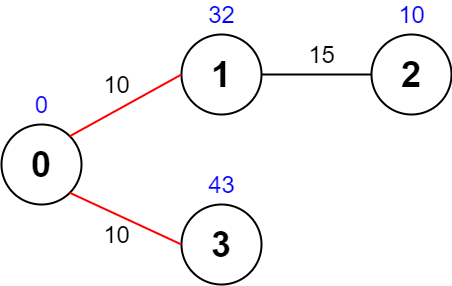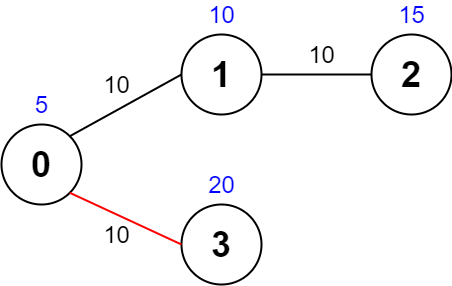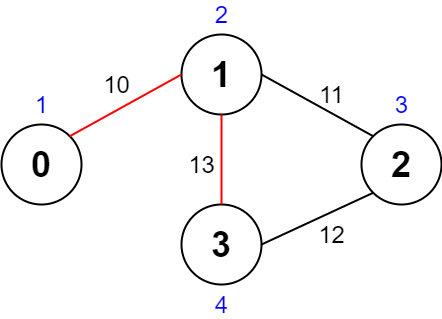Maximum Path Quality of a Graph
Problem
There is an undirected graph with n nodes numbered from 0 to n - 1
(inclusive). You are given a 0-indexed integer array values where
values[i] is the value of the ith node. You are also given a
0-indexed 2D integer array edges, where each edges[j] = [uj, vj, timej] indicates that there is an undirected edge between the nodes uj and
vj, and it takes timej seconds to travel between the two nodes. Finally, you are given an integer maxTime.
A valid path in the graph is any path that starts at node 0, ends at node 0, and takes at most maxTime seconds to complete. You may visit the same node multiple times. The quality of a valid path is the sum of the values of the unique nodes visited in the path (each node's value is added at most once to the sum).
Return themaximum quality of a valid path.
Note: There are at most four edges connected to each node.
Examples
Example 1

Input: values = [0,32,10,43], edges = [[0,1,10],[1,2,15],[0,3,10]], maxTime = 49
Output: 75
Explanation:
One possible path is 0 -> 1 -> 0 -> 3 -> 0. The total time taken is 10 + 10 + 10 + 10 = 40 <= 49.
The nodes visited are 0, 1, and 3, giving a maximal path quality of 0 + 32 + 43 = 75.
Example 2

Input: values = [5,10,15,20], edges = [[0,1,10],[1,2,10],[0,3,10]], maxTime = 30
Output: 25
Explanation:
One possible path is 0 -> 3 -> 0. The total time taken is 10 + 10 = 20 <= 30.
The nodes visited are 0 and 3, giving a maximal path quality of 5 + 20 = 25.
Example 3

Input: values = [1,2,3,4], edges = [[0,1,10],[1,2,11],[2,3,12],[1,3,13]], maxTime = 50
Output: 7
Explanation:
One possible path is 0 -> 1 -> 3 -> 1 -> 0. The total time taken is 10 + 13 + 13 + 10 = 46 <= 50.
The nodes visited are 0, 1, and 3, giving a maximal path quality of 1 + 2 + 4 = 7.
Constraints
n == values.length1 <= n <= 10000 <= values[i] <= 10^80 <= edges.length <= 2000edges[j].length == 30 <= uj < vj <= n - 110 <= timej, maxTime <= 100- All the pairs
[uj, vj]are unique. - There are at most four edges connected to each node.
- The graph may not be connected.
Solution
Method 1 – Backtracking with State Tracking
Intuition
Since the graph is small (at most 100 nodes, each with at most 4 edges), we can use backtracking (DFS) to explore all valid paths starting and ending at node 0 within the time limit. We keep track of the set of unique nodes visited and the current path quality, updating the answer whenever we return to node 0.
Approach
- Build the adjacency list for the graph from the edges.
- Use DFS to explore all paths starting from node 0, tracking:
- The current node, time used, current path quality, and a visited count for each node.
- When visiting a node for the first time, add its value to the current quality.
- If we return to node 0 within the time limit, update the answer with the current quality.
- For each neighbor, if the next time does not exceed maxTime, recurse.
- Backtrack the visited count after recursion.
- Return the maximum quality found.
Code
C++
class Solution {
public:
int maxQuality = 0;
void dfs(int u, int time, int quality, vector<int>& values, vector<vector<pair<int,int>>>& g, vector<int>& vis, int maxTime) {
if (vis[u] == 0) quality += values[u];
vis[u]++;
if (u == 0) maxQuality = max(maxQuality, quality);
for (auto& [v, t] : g[u]) {
if (time + t <= maxTime) {
dfs(v, time + t, quality, values, g, vis, maxTime);
}
}
vis[u]--;
}
int maximalPathQuality(vector<int>& values, vector<vector<int>>& edges, int maxTime) {
int n = values.size();
vector<vector<pair<int,int>>> g(n);
for (auto& e : edges) {
g[e[0]].push_back({e[1], e[2]});
g[e[1]].push_back({e[0], e[2]});
}
vector<int> vis(n, 0);
dfs(0, 0, 0, values, g, vis, maxTime);
return maxQuality;
}
};
Go
func maximalPathQuality(values []int, edges [][]int, maxTime int) int {
n := len(values)
g := make([][][2]int, n)
for _, e := range edges {
g[e[0]] = append(g[e[0]], [2]int{e[1], e[2]})
g[e[1]] = append(g[e[1]], [2]int{e[0], e[2]})
}
ans := 0
vis := make([]int, n)
var dfs func(u, time, quality int)
dfs = func(u, time, quality int) {
if vis[u] == 0 {
quality += values[u]
}
vis[u]++
if u == 0 {
if quality > ans {
ans = quality
}
}
for _, e := range g[u] {
v, t := e[0], e[1]
if time + t <= maxTime {
dfs(v, time + t, quality)
}
}
vis[u]--
}
dfs(0, 0, 0)
return ans
}
Java
class Solution {
int ans = 0;
public int maximalPathQuality(int[] values, int[][] edges, int maxTime) {
int n = values.length;
List<int[]>[] g = new List[n];
for (int i = 0; i < n; i++) g[i] = new ArrayList<>();
for (int[] e : edges) {
g[e[0]].add(new int[]{e[1], e[2]});
g[e[1]].add(new int[]{e[0], e[2]});
}
int[] vis = new int[n];
dfs(0, 0, 0, values, g, vis, maxTime);
return ans;
}
void dfs(int u, int time, int quality, int[] values, List<int[]>[] g, int[] vis, int maxTime) {
if (vis[u] == 0) quality += values[u];
vis[u]++;
if (u == 0) ans = Math.max(ans, quality);
for (int[] e : g[u]) {
int v = e[0], t = e[1];
if (time + t <= maxTime) {
dfs(v, time + t, quality, values, g, vis, maxTime);
}
}
vis[u]--;
}
}
Kotlin
class Solution {
var ans = 0
fun maximalPathQuality(values: IntArray, edges: Array<IntArray>, maxTime: Int): Int {
val n = values.size
val g = Array(n) { mutableListOf<Pair<Int, Int>>() }
for (e in edges) {
g[e[0]].add(e[1] to e[2])
g[e[1]].add(e[0] to e[2])
}
val vis = IntArray(n)
fun dfs(u: Int, time: Int, quality: Int) {
var q = quality
if (vis[u] == 0) q += values[u]
vis[u]++
if (u == 0) ans = maxOf(ans, q)
for ((v, t) in g[u]) {
if (time + t <= maxTime) dfs(v, time + t, q)
}
vis[u]--
}
dfs(0, 0, 0)
return ans
}
}
Python
class Solution:
def maximalPathQuality(self, values: list[int], edges: list[list[int]], maxTime: int) -> int:
from collections import defaultdict
g = defaultdict(list)
for u, v, t in edges:
g[u].append((v, t))
g[v].append((u, t))
n = len(values)
ans = 0
vis = [0] * n
def dfs(u: int, time: int, quality: int):
nonlocal ans
if vis[u] == 0:
quality += values[u]
vis[u] += 1
if u == 0:
ans = max(ans, quality)
for v, t in g[u]:
if time + t <= maxTime:
dfs(v, time + t, quality)
vis[u] -= 1
dfs(0, 0, 0)
return ans
Rust
impl Solution {
pub fn maximal_path_quality(values: Vec<i32>, edges: Vec<Vec<i32>>, max_time: i32) -> i32 {
use std::collections::HashMap;
let n = values.len();
let mut g = vec![vec![]; n];
for e in &edges {
g[e[0] as usize].push((e[1] as usize, e[2]));
g[e[1] as usize].push((e[0] as usize, e[2]));
}
let mut vis = vec![0; n];
let mut ans = 0;
fn dfs(u: usize, time: i32, quality: i32, values: &Vec<i32>, g: &Vec<Vec<(usize, i32)>>, vis: &mut Vec<i32>, max_time: i32, ans: &mut i32) {
let mut q = quality;
if vis[u] == 0 {
q += values[u];
}
vis[u] += 1;
if u == 0 {
*ans = (*ans).max(q);
}
for &(v, t) in &g[u] {
if time + t <= max_time {
dfs(v, time + t, q, values, g, vis, max_time, ans);
}
}
vis[u] -= 1;
}
dfs(0, 0, 0, &values, &g, &mut vis, max_time, &mut ans);
ans
}
}
TypeScript
class Solution {
maximalPathQuality(values: number[], edges: number[][], maxTime: number): number {
const n = values.length;
const g: [number, number][][] = Array.from({length: n}, () => []);
for (const [u, v, t] of edges) {
g[u].push([v, t]);
g[v].push([u, t]);
}
let ans = 0;
const vis = new Array(n).fill(0);
function dfs(u: number, time: number, quality: number) {
if (vis[u] === 0) quality += values[u];
vis[u]++;
if (u === 0) ans = Math.max(ans, quality);
for (const [v, t] of g[u]) {
if (time + t <= maxTime) dfs(v, time + t, quality);
}
vis[u]--;
}
dfs(0, 0, 0);
return ans;
}
}
Complexity
- ⏰ Time complexity:
O(4^n)in the worst case, but practical due to small graph size and pruning by maxTime. - 🧺 Space complexity:
O(n)for the recursion stack and visited array.